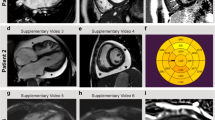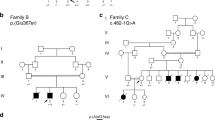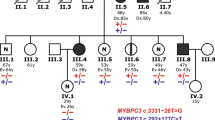Abstract
Familial hypertrophic cardiomyopathy (FHC) is an autosomal dominant disease characterized by a ventricular hypertrophy predominantly affecting the inter-ventricular septum and associated with a large extent of myocardial and myofibrillar disarray1. It is the most common cause of sudden death in the young. In the four disease loci found, three genes have been identified which code for β-myosin heavy chain, cardiac tro-ponin T and α-tropomyosin2–7. Recently the human cardiac myosin binding protein-C (MyBP-C) gene was mapped to chromosome 11p11.2 (ref. 8), making this gene a good candidate for the fourth locus, CMH4 (ref. 5). Indeed, MyBP-C is a substantial component of the myofibrils that interacts with several proteins of the thick filament of the sarcomere9–13. In two unrelated French families linked to CMH4, we found a mutation in a splice acceptor site of the MyBP-C gene, which causes the skipping of the associated exon and could produce truncated cardiac MyBP-Cs. Mutations in the cardiac MyBP-C gene likely cause chromosome 11-linked hypertrophic cardiomyopathy, further supporting the hypothesis that hypertrophic cardiomyopathy results from mutations in genes encoding contractile proteins.
This is a preview of subscription content, access via your institution
Access options
Subscribe to this journal
Receive 12 print issues and online access
$209.00 per year
only $17.42 per issue
Buy this article
- Purchase on Springer Link
- Instant access to full article PDF
Prices may be subject to local taxes which are calculated during checkout
Similar content being viewed by others
References
Maron, B.J. et al. Hypertrophic cardiomyopathy: interrelations of clinical manifestations, pathophysiology, and therapy (first of two parts). New Engl. J. Med. 316, 780–789 (1987).
Jarcho, J.A. et al. Mapping a gene for familial hypertrophic cardiomyopathy to chromosome 14ql. New Engl. J. Med. 321, 1372–1378 (1989).
Watkins, H. et al. A disease locus for familial hypertrophic cardiomyopathy maps to chromosome 1q3. Nature Genet. 3, 333–337 (1993).
Thierfelder, L. et al. A familial hypertrophic cardiomyopathy locus maps to chromosome 15q2. Proc. natn. Acad. Sci. U.S.A. 90, 6270–6274 (1993).
Carrier, L. et al. Mapping of a novel gene for familial hypertrophic cardiomyopathy to chromosome 11. Nature Genet. 4, 311–313 (1993).
Geisterfer-Lowrance, A.A.T. et al. A molecular basis for familial hypertrophic cardiomyopathy: a β cardiac myosin heavy chain gene missense mutation. Cell 62, 999–1006 (1990).
Thierfelder, L. et al. α-troppmyosin and cardiac troponin T mutations cause familial hypertrophic cardiomyopathy: a disease of the sarcomere. Cell 77, 701–712 (1994).
Gautel, M., Zuffardi, O., Freiburg, A. & Labeit, S. Phospnorylation switches specific for the cardiac isoform of myosin binding protein C: a modulator of cardiac contraction? EMBO J. 14, 1952–1960 (1995).
Offer, G., Moos, C. & Starr, R. A new protein of the thick filaments of vertebrate skeletal myofibrils. J. molec. Biol. 74, 653–676 (1973).
Starr, R. & Offer, G. The interaction of C-protein with heavy meromyosin and subfragment-2. Biochem. J. 171, 813–616 (1978).
Moos, C., Mason, C.M., Besterman, J.M., Feng, I.N.M. & Dubin, J.H. The binding of skeletal muscle C-protein to F-actin, and its relation to the interaction of actin with myosin subfragment-1. J. molec. Biol. 124, 571–586 (1978).
Yamamoto, K. & Moos, C., The C-proteins of rabbit red, white, and cardiac muscles. J. biol. Chem. 258, 8395–8401 (1983).
Fürst, D.O., Vinkemeyer, U. & Weber, K. Mammalian skeletal muscle C-protein: purification from bovine muscle, binding to titin and the characterization of a full-length cDNA. J. Cell Sci. 102, 769–778 (1992).
James, M.R. et al. A radiation hybrid map of 506 STS markers spanning human chromosome 11. Nature Genet. 8, 70–76 (1994).
Einheber, S. & Fischman, D. Isolation and characterization of a cDNA clone encoding avian skeletal muscle C-protein: an intracellular member of the immunoglobulin superfamily. Proc. natn. Acad. Sci. U.S.A. 87, 2157–2161 (1990).
Okagaki, T. et al. The major myosin-binding domain of skeletal muscle MyBP-C (C protein) resides in the COOH-terminal, immunoglobulin C2 motif. J. Cell Biol. 123, 619–626 (1993).
Koretz, J.F., Coluccio, L.M. & Bertasso, A.M. The aggregation characteristics of column-purified rabbit skeletal myosin in the presence and absence of C-protein at pH 7.0. Biophys. J. 37, 433–440 (1982).
Moos, C. & Feng, I.N.M. Effect of C-Protein on actomyosin ATPase. Biochem. biophys. Acta 632, 141–149 (1980).
Hofmann, P.A., Hartzell, H.C. & Moss, R.L. Alterations in Ca2+ sensitive tension due to partial extraction of C-protein from rat skinned cardiac myocytes and rabbit skeletal muscle fibers. J. gen. Physiol. 97, 1141–1163 (1991).
Granzier, H.L. & Irving, T.C. Passive tension in cardiac muscle: contribution of collagen, titin, microtubules, and intermediate filaments. Biophys. J. 68, 1027–1044 (1995).
de Tombe, P. & ter Keurs, H. An internal viscous element limits unloaded velocity of sarcomere shortening in rat myocardium. J. Physiol. 454, 619–642 (1992).
Sweitzer, N. & Moss, R. Determinants of loaded shortening velocity in single cardiac myocytes permeabilized with α-hemolysin. Circulation Res. 73, 1150–1162 (1993).
Hartzell, H.C. & Titus, L. Effects of cholinergic and adrenergic agonists on phosphorylation of a 165,000-dalton myofibrillar protein in intact cardiac muscle. J. biol. Chem. 257, 2111–2120 (1982).
Schwartz, K. et al. Exclusion of myosin heavy chain and cardiac actin gene involvement in hypertrophic cardiomyopathies of several French families. Circulation Res. 71, 3–8 (1992).
Weissenbach, J. et al. A second generation linkage map of the human genome. Nature 359, 794–801 (1992).
Vignal, A. Nonradioactive multiplex procedure for genotyping of microsatellite markers in Methods in Molecular Genetics: Chromosome and Gene Analysis 1 (ed. K.W. Adolph), 211–221 (Academic Press, Oriando, Florida, 1993).
Don, R.H., Cox, P.T., Wainwright, B.J., Baker, K. & Mattick, J.S. Touchdown PCR to circumvent spurious priming during gene amplification. Nucl. Acids Res. 19, 4008 (1991).
Ott, J. Linkage analysis and family classification under heterogeneity. Ann. hum. Genet. 47, 311–320 (1983).
Bonne, G., Carrier, L., Komajda, M. & Schwartz, K. The COX8 gene is not the disease gene of the CMH4 locus in Familial Hypertrophic Cardiomyopathy. J. med. Genet. 32, 670–671 (1995).
Author information
Authors and Affiliations
Rights and permissions
About this article
Cite this article
Bonne, G., Carrier, L., Bercovici, J. et al. Cardiac myosin binding protein–C gene splice acceptor site mutation is associated with familial hypertrophic cardiomyopathy. Nat Genet 11, 438–440 (1995). https://doi.org/10.1038/ng1295-438
Received:
Accepted:
Issue Date:
DOI: https://doi.org/10.1038/ng1295-438
This article is cited by
-
Etiology of genetic muscle disorders induced by mutations in fast and slow skeletal MyBP-C paralogs
Experimental & Molecular Medicine (2023)
-
Cryo-electron tomography of intact cardiac muscle reveals myosin binding protein-C linking myosin and actin filaments
Journal of Muscle Research and Cell Motility (2023)
-
Mechanisms of Sarcomere Protein Mutation-Induced Cardiomyopathies
Current Cardiology Reports (2023)
-
Identification of an elusive spliceogenic MYBPC3 variant in an otherwise genotype-negative hypertrophic cardiomyopathy pedigree
Scientific Reports (2022)
-
Rapid whole genome sequencing impacts care and resource utilization in infants with congenital heart disease
npj Genomic Medicine (2021)



